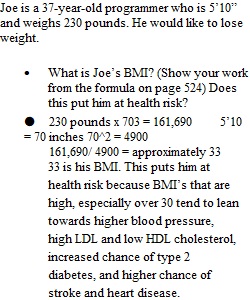


Q Joe is a 37-year-old programmer who is 5’10” and weighs 230 pounds. He would like to lose weight. 1. What is Joe’s BMI? (Show your work from the formula on page 524) Does this put him at health risk? 2. Consider the ABCD of assessment from Chapter 1. Other than BMI, what else would you consider when considering Joe’s health risk? (2 points) 3. Joe decides to commit to long-term weight loss that is more likely to last. List and summarize the some key strategies (at least three) for healthful weight loss as described in our text. 4. Successful weight management involves reduced calories, increased physical activity and behavior modification? Explain behavior modification and suggest THREE behavior modification techniques that might be good for Joe. (2 points) 5. Calculate Joe’s energy needs based on the Harris Benedict Equation in the Calculation Corner on page 518. Which activity factor would you use using Table 14.3? Based on his calorie needs, how many calories would you prescribe to Joe to promote weight loss? Why do recommend this? (2 points) 6. Go to the National Weight Control Registry website. What are four things that Joe can learn from other people that will help him avoid gaining the weight back? 7. Research indicates that people who eat the majority of their calories earlier in the day (breakfast) have better success at weight management. Why do you think that is the case?
View Related Questions